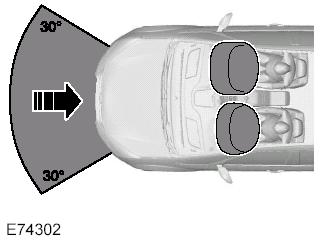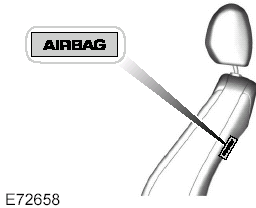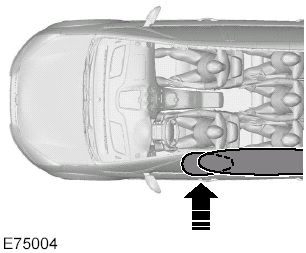Ford Fusion: Principle of operation
 Ford Fusion: Principle of operation
Ford Fusion: Principle of operation
Airbags
WARNINGS:
Do not modify the front of yourvehicle in any way. This couldadversely affect deployment of theairbags.
Original text according to ECER94.01: Extreme Hazard! Do not usea rearward facing child restraint ona seat protected by an airbag in front ofit!Wear a seat belt and keep sufficientdistance between yourself and thesteering wheel. Only when you usethe seat belt properly, can it hold you in aposition that allows the airbag to achieveits optimum effect. See Sitting in thecorrect position.
Have repairs to the steering wheel,steering column, seats, airbags andseat belts carried out by properlytrained technicians.
Keep the areas in front of theairbags free from obstruction. Donot affix anything to or over theairbag covers.
Do not poke sharp objects intoareas where airbags are fitted. Thiscould damage and adversely affectdeployment of the airbags.
Use seat covers designed for seatswith side airbags. Have these fittedby properly trained technicians.
Note: You will hear a loud bang and seea cloud of harmless powdery residue if anairbag deploys. This is normal.
Note: Only wipe airbag covers with adamp cloth.
The restraint system comprises:
• a driver airbag.
• a front passenger airbag.
• side airbags.
• curtain airbags.
• a driver seat belt pretensioner.
• a front passenger seat belt pretensioner.
• crash sensors.
• an airbag warning lamp.
• a seat belt reminder.
• an electronic control and diagnostic unit.
You can also have your vehicle fitted with:
• an airbag deactivation switch.
• an airbag deactivation warning lamp.

Driver and front passenger airbags
The driver and front passenger airbagswill deploy during significant frontalcollisions or collisions that are up to 30degrees from the left or the right. Theairbags will inflate within a fewthousandths of a second and deflate oncontact with the occupants, thuscushioning forward body movement.
During minor frontal collisions, overturns,rear collisions and side collisions, the driverand front passenger airbags will notdeploy.

Side airbags
Side airbags are fitted inside the seatbackof the front seats. A label indicates thatside airbags are fitted to your vehicle.
The side airbags will deploy duringsignificant lateral collisions. Only the airbagon the side affected by the collision willdeploy. The airbags will inflate within a fewthousandths of a second and deflate oncontact with the occupants, thusproviding protection for the chest andshoulder areas. During minor lateralcollisions, overturns, front collisions andrear collisions, the side airbags will notdeploy.

Curtain airbags
Curtain airbags are fitted inside the trimpanels over the front and rear sidewindows. Moulded badges in the B-pillartrim panels indicate that curtain airbagsare fitted to your vehicle.
The curtain airbags will deploy duringsignificant lateral collisions. Only the airbagon the side affected by the collision willdeploy. The airbag will inflate within a fewthousandths of a second and deflate oncontact with the occupants, thusproviding protection for the head. Duringminor lateral collisions, front collisions, rearcollisions, or overturns the curtain airbagswill not deploy.
Seat belts
WARNINGS:
Wear a seat belt and keep sufficientdistance between yourself and thesteering wheel. Only when you usethe seat belt properly, can it hold you in aposition to achieve its optimum effect.
See Sitting in the correct position.
Never use a seat belt for more thanone person.
Use the correct buckle for each seatbelt.
Do not use a seat belt that is slackor twisted.
Do not wear thick clothing. The seatbelt must fit tightly around your bodyto achieve its optimum effect.
Position the shoulder strap of theseat belt over the centre of yourshoulder and position the lap straptightly across your hips.
The driver and front passenger seat beltretractors are fitted with a seat beltpretensioner. Seat belt pretensionershave a lower deployment threshold thanthe airbags. During minor collisions, it ispossible that only the seat beltpretensioners will deploy.


